A major exhibition examines the link between Harry Seidler’s architecture and the artists he loved. Words by Stephen Lacey.
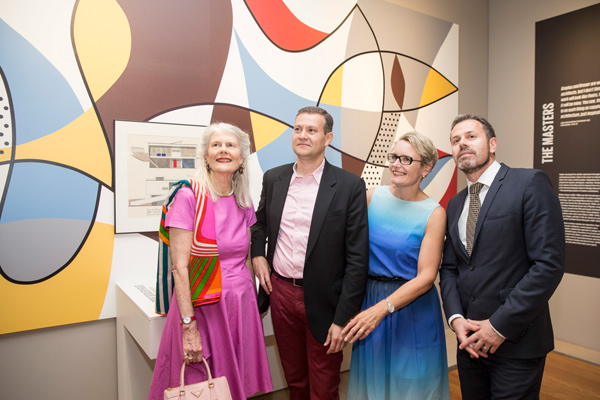
November 10th, 2014
Above: Penelope Seidler, co-curators Vladimir Belogolovsky & Caroline Butler-Bowden and director of Sydney Living Musuems Mark Goggin. In front of reproduction of Harry Seidler’s mural at Rose Seidler House.
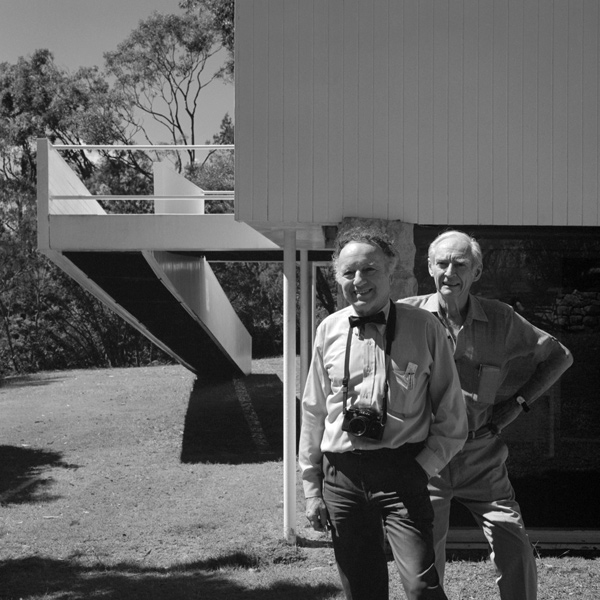
Harry Seidler with Max Dupain at Rose Seidler House 1991 by and copyright Eric Sierins
Der zeit ihre kunst. Der kunst ihre freiheit”.- to every age its art and to art its freedom.
(Written above the entrance to the Viennese Secession Pavillion).
A new exhibition opened this week at the Museum of Sydney, celebrating the work of the late great architect Harry Seidler and his collaborative relationships with some of the most influential artists, designers and engineers of the 20th century.
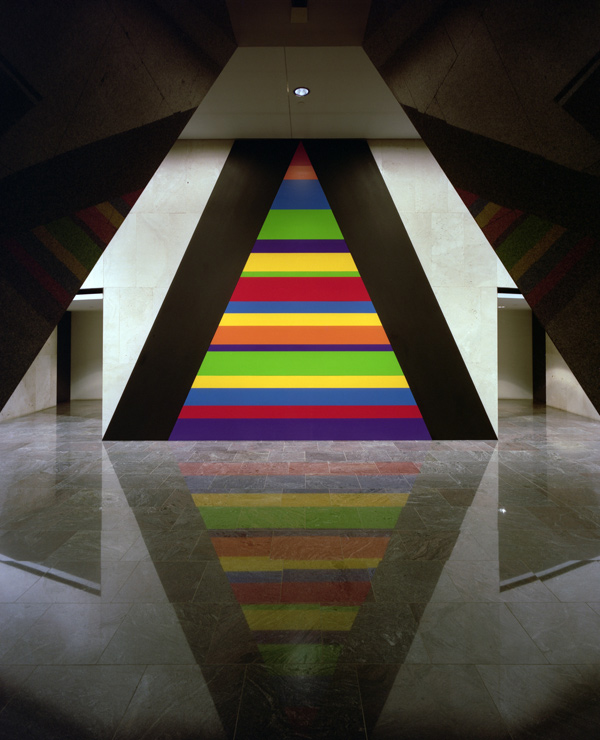
The Horizon lobby showcasing artwork by Sol LeWitt “Wall Drawing #898 Irregular horizontal bands of color within a triangle.” 1998-99. Photo 1999 by and copyright Eric Sierins
The exhibition has been assembled by NYC-based former architect and now architectural curator, Vladamir Belogolovsky, assisted by Dr Caroline Butler-Bowden, from Sydney Living Museums.
Belogolovsky became fascinated with Seidler and his work after being invited to Australia to give a talk on Spanish architecture in 2010.
“I was really impressed with Harry’s buildings,” Belogolovsky says. “Walking around Sydney, gazing up at his tall towers, I knew then and there that I wanted to exhibit his work.”
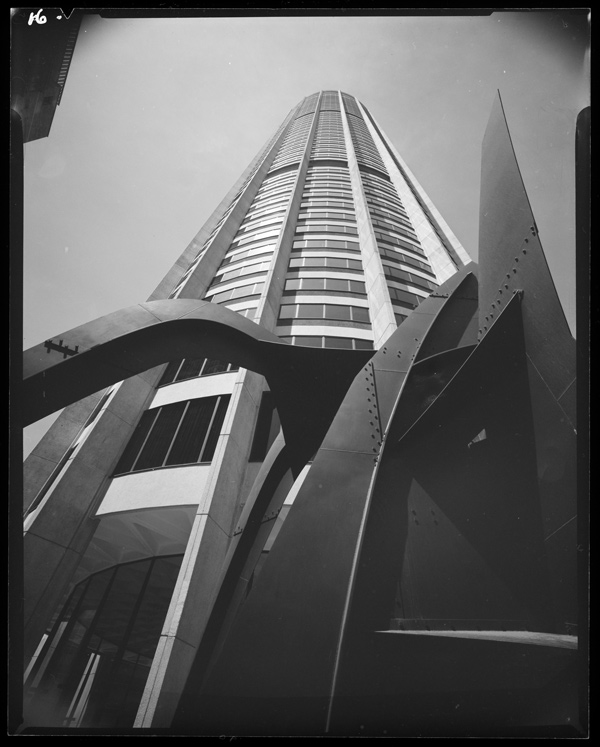
Australia Square with “Crossed Blades” sculpture by Alexander Calder. Photo by Max Dupain 1968. Copyright Penelope Seidler.
The initial idea was for a simple exhibition in a lobby area. However the architect’s wife Penelope Seidler encouraged Belogolovsky to create a larger exhibition and she agreed for him to take it on a world tour.
The Seiler exhibition has since opened in 11 sites across Europe, North America and South America, before hitting Sydney. The current incarnation of the exhibition boasts far more original artworks than the travelling version, as well as much information on Seidler’s childhood in Vienna and his time in internment camps in 1940-41. Next year the show will go onto Vienna and Barcelona and discussions are underway to take it to the Bauhaus; a school which through its émigré teachers in the US, had a huge influence on Seidler’s modernist architectural method.
The name for the current incarnation of the exhibition comes from an article written by Seidler in 1949 called Painting Towards Architecture. It was based on a book from the previous year by Henry-Russell Hitchcock.
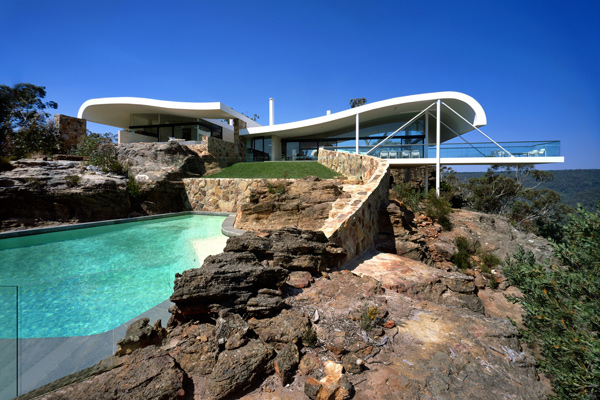
Berman House, Joadja NSW. 2000 Photo by and copyright Eric Sierins
Belogolovsky says the show explores the links between Seidler’s architecture and the visual arts. For example the dynamic façade of Blues Point Tower (created by the way Seidler offset corner windows with strip windows) is reminiscent of a painting called The City by painter Joseph Albers, who Seidler studied under at Black Mountain College in USA in 1946.
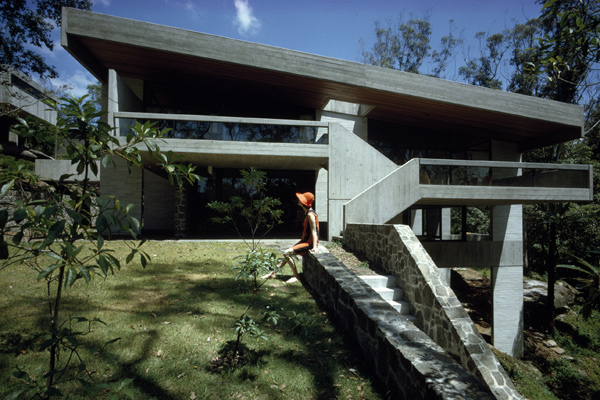
Harry and Penelope Seidler House, Killara NSW with Penelope in foreground 1967. Photography by Harry Seidler. Copyright Penelope Seidler
“Frank Stella, Norman Carlberg, Charles Perry…these artists had a very direct connection to Harry’s work; his buildings are based on exactly the same principles geometrically.”
“A great example is the Trade Group Offices in Canberra (now called the Edmund Barton Building). That building in plan is based on exactly the same geometry as Carlberg’s Black Widow, a sculpture in the western forecourt. I’m referring to the repetition of quadrants, semi-circles, squares and rectangles, in floor plans, the site plan, even the fountain.”
Another example that features prominently in the exhibition is the link between Seidler’s favourite painting: Construction in Space Time III, by Theo Van Doesberg, and the design of his family home at Killara.
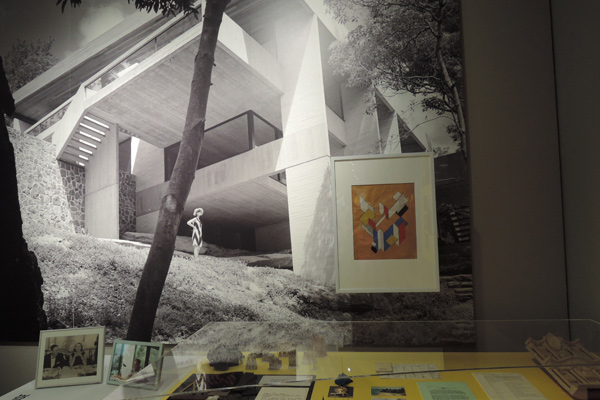
Above: Footage shows Harry Seidler with US architect Phillip Johnson in his New York office 1960, two Marcel Breuer “Wassily” chairs from Seidler House, Killara, and photo of Harry and Penelope Seidler in 2005 by Petrina Hicks. Black and white Max Dupain photo of Penelope beneath Harry and Penelope Seidler House, Killara 1967 and on the right is and on the right is the Theo Van Doesburg artwork “Space Time Construction #3” 1923. (Photos courtesy Penelope Seidler).
“In the painting you notice the intersection of colourful panels floating in space,” says Belogolovsky. “This was translated by Harry into floating panels of concrete, brick and glass. The site itself provided the opportunity to work in the vertical dimension. Initially the house appears as an ordinary two story house, but once you go inside you see the way the house is split in two and then shifted; so all of a sudden you have four and a half levels.”
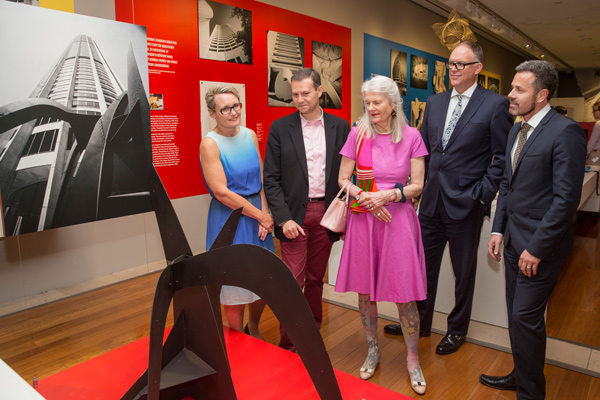
Above: Co-curators Caroline Butler-Bowden & Vladimir Belogolovsky, Penelope Seidler, Michael Rose (chairman of Sydney LIving Museums) and Mark Goggin (director of Sydney Living Musuems) with maquette of Alexander Calder’s “crossed blades” sculpture for Australia Square.
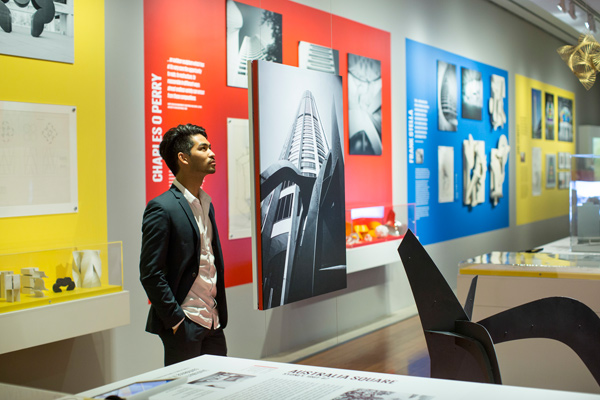
Above: Left yellow wall with maquettes by sculptor Norman Carlberg and right suspended maquette of Charles O. Perry’s metal sculpture “Mercator” (1975) for Sydney’s Theatre Royal (part of MLC Centre).
By coincidence, Construction in Space Time III was painted in the year of Seidler’s birth, 1923. When the work became for sale in 1992, Penelope Seidler convinced her husband to buy the artwork he so loved. The painting was donated to the National Gallery of Australia, Canberra in 2010; a few years after the architect passed away in 2006.
Other highlights of the exhibition include miniature sculptures by Norman Carlberg, and a hand-written letter from Seidler to the sculptor in 1969, acknowledging the influence on his work. There is also an ensemble of letters between Seidler and the sculptor Alexander Calder from 1967 for the Australia Square sculpture “Crossed Blades”.
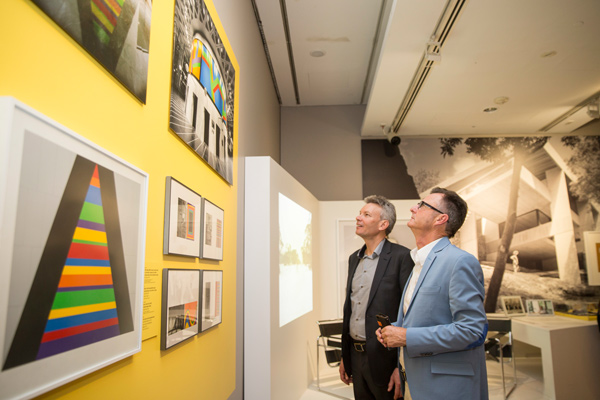
Above: Sol LeWitt wall showing maquette for Sol LeWitt’s artwork for Horizon tower “Wall Drawing #898 Irregular horizontal bands of color within a triangle”
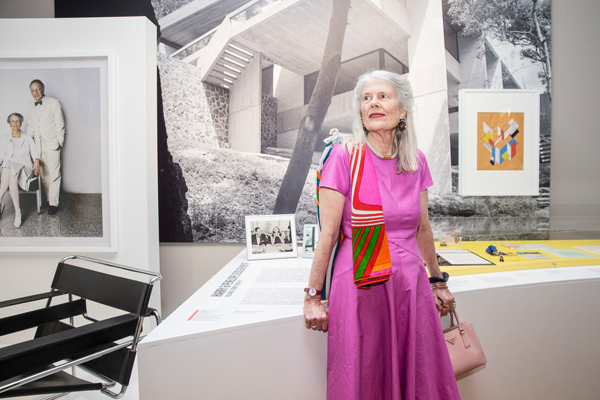
Above: Penelope Seidler at exhibition: on left is photo of of her and Harry by Petrina Hicks of 2005, behind is Max Dupain photo of her beneath Harry and Penelope Seidler House, Killara 1967 and on the right is the Theo Van Doesburg artwork “Space Time Construction #3” 1923.
Exhibition photography by James Horan for and copyright Sydney Living Musuems
Painting Towards Architecture is at the Museum of Sydney until March 8, 2015.
Sydney Living Museums
sydneylivingmuseums.com.au
INDESIGN is on instagram
Follow @indesignlive
A searchable and comprehensive guide for specifying leading products and their suppliers
Keep up to date with the latest and greatest from our industry BFF's!

From the spark of an idea on the page to the launch of new pieces in a showroom is a journey every aspiring industrial and furnishing designer imagines making.

At the Munarra Centre for Regional Excellence on Yorta Yorta Country in Victoria, ARM Architecture and Milliken use PrintWorks™ technology to translate First Nations narratives into a layered, community-led floorscape.

In an industry where design intent is often diluted by value management and procurement pressures, Klaro Industrial Design positions manufacturing as a creative ally – allowing commercial interior designers to deliver unique pieces aligned to the project’s original vision.

From Krost comes the Zak chair – a contemporary seating solution that redefines the modern office landscape.
DQ Editor Alice Blackwood checked out Melbourne Bikefest’s Better by Bike awards on Thursday 25 November 2010. Alice, who was also on the judging panel, recaps the finalists and winners.
The internet never sleeps! Here's the stuff you might have missed
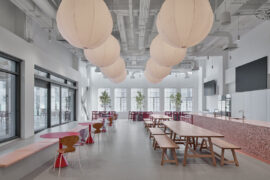
The new headquarters for Omnicom in Melbourne’s CBD sees heritage re-invigorated with style and finesse.
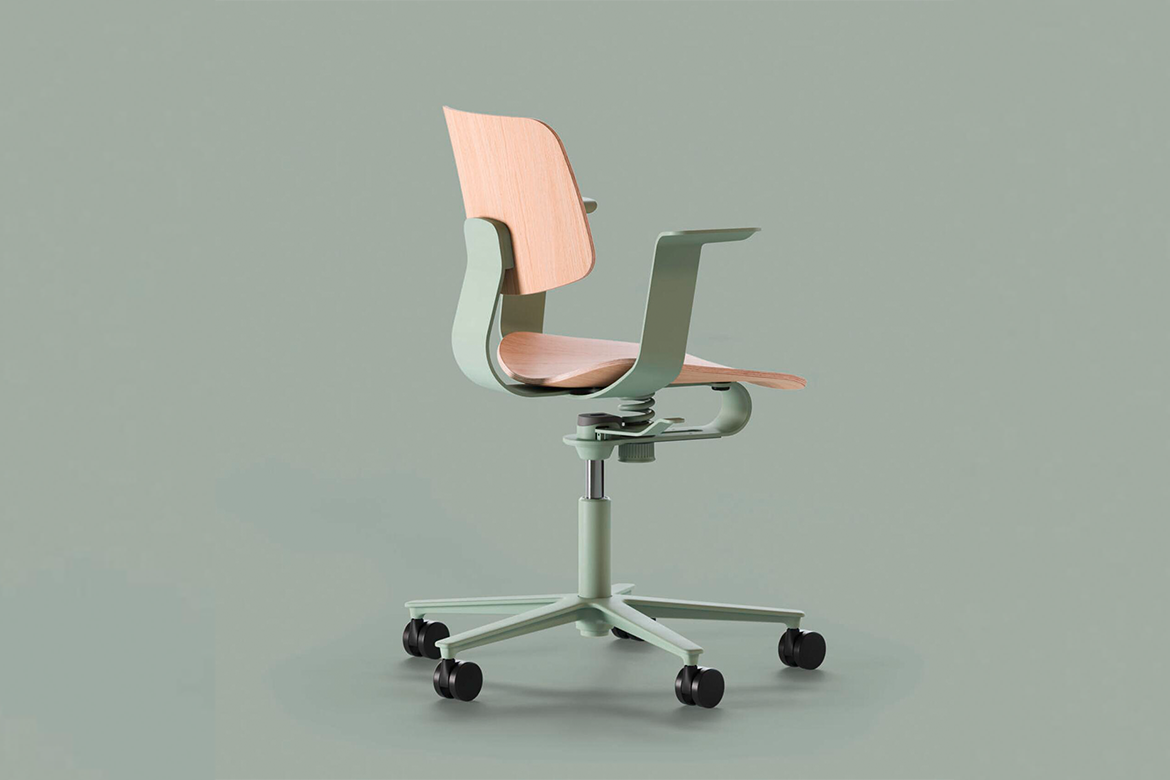
True sustainability doesn’t have to be complicated. As Wilkhahn demonstrate with their newest commercial furniture range.

The Simple Living Passage marks the final project in the Simple World series by Jenchieh Hung + Kulthida Songkittipakdee of HAS design and research, transforming a retail walkway in Hefei into a reflective public space shaped by timber and movement.